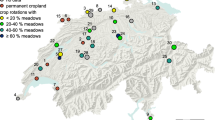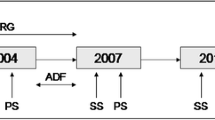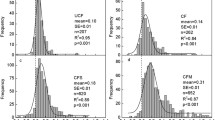Abstract
Since 2003, the regional long-term soil monitoring network (SMN) Schleswig–Holstein (SH) includes an intensive monitoring program (I-BDF) with (sub-)annual measurements at four sites. This is the first study investigating the benefits of this SMN where study sites are no experiments but managed by independent farmers. The main objective of this study was to investigate whether, and under which circumstances, annual soil carbon and nutrient measurements are more beneficial within a soil monitoring network than common five- to ten-year measurements using modeling and nutrient balances. Soil measurements (stocks of soil organic carbon (SOC), Ntot, P and Mg), weekly leachate-NO3–N and management data were used for comparison. C and N changes were modeled with DNDC (DeNitrification–DeComposition); P and Mg were calculated as full nutrient balances and compared to the observations using performance metrics. The results show that DNDC could reproduce the long-term trend of SOC and Ntot well, but this could also be by coincidence as the type of trendline depended on the starting year. The model results could not depict measured short-term variations in soil which were due to field heterogeneities caused by farm management. NO3-N leaching was strongly overestimated when organic fertilization and stronger rainfall occurred. Comparing stock changes with nutrient balances revealed that, in several cases, long-term trends could be shown to a limited extent and reproduced only very few short-term changes and variations. The results suggest that only annual soil property measurements can depict the soil’s variability and contribute to the identification of the true long-term trend.




Similar content being viewed by others
References
Addiscott TM, Whitmore AP (1987) Computer simulation of changes in soil mineral nitrogen and crop nitrogen during autumn, winter and spring. J Agric Sci Camb 109:141–157
Ad-Hoc-AG Boden (2005) Bodenkundliche Kartieranleitung, 5th edn. Hannover, Berlin
Arrouays D, Jolivet C, Boulonne L, Bodineau G, Saby N, Grolleau E (2002) A new projection in France: a multi-institutional soil quality monitoring network. Comptes Rendus de l’Académie d’Agriculture de France (France)
Brilli L, Bechini L, Bindi M, Carozzi M, Cavalli D, Conant R, Ferrise R, Bellochi G (2017) Review and analysis of strengths and weaknesses of agro-ecosystem models for simulating C and N fluxes. Sci Total Environ 598:445–470
Bünemann EK, Bongiorno G, Bai Z, Creamer RE, De Deyn G, de Goede R, Brussaard L (2018) Soil quality–a critical review. Soil Biol Biochem 120:105–125
Chen Z, Wang J, Deng N, Lv C, Wang Q, Yu H, Li W (2018) Modeling the effects of farming management practices on soil organic carbon stock at a county-regional scale. CATENA 160:76–89
Congreves KA, Dutta B, Grant BB, Smith WN, Desjardins RL, Wagner-Riddle C (2016) How does climate variability influence nitrogen loss in temperate agroecosystems under contrasting management systems? Agric Ecosyst Environ 227:33–41
Desaules A (2012) Measurement instability and temporal bias in chemical soil monitoring: sources and control measures. Environ Monit Assess 184(1):487–502
DVWK (1996) Ermittlung der Verdunstung von Land- und Wasserflächen. Deutscher Verband für Wasserwirtschaft und Kulturbau e. V. (DVWK), Merkblätter zur Wasserwirtschaft 238/1996. Kommissionsbetrieb Wirtschafts- und Verlagsgesellschaft Gas und Wasser mbH, Bonn
DWD (2017) Deutscher Wetterdienst: Weather data (daily maximum and minimum temperature, relative humidity and wind speed) of the weather stations Strucklahnungshörn, Hattstedt, Bordelum, Kiel-Leuchtturm, Schönhagen and Osdorf; for the time period from 2005 to 2015
Egner H, Riem H, Domingo WR (1960) Untersuchungen über die chemische Bodenanalyse als Grundlage für Beurteilung des Nährstoffzustandes der Böden. II. Chemische Extraktionsmethoden zur Phosphor- und Kaliumbestimmung. Kungl Lantbrukhoegskolan Annonsera Ann 26:199–215
Franko U, Oelschlägel B, Schenk S (1995) Simulation of temperature-, water- and nitrogen dynamics using the model CANDY. Ecol Model 81:213–222
Frolking SE, Mosier AR, Ojima DS, Li C, Parton WJ, Potter CS, Priesack E, Stenger R, Haberbosch C, Dörsch P, Flessa H, Smith KA (1998) Comparison of N2O emissions from soils at three temperate agricultural sites: simulations of year-round measurements by four models. Nutr Cycl Agroecosyst 52:77–105
Giani L, Makowsky L, Mueller K (2014) Plaggic Anthrosol: soil of the year 2013 in Germany: an overview on its formation, distribution, classification, soil function and threats. J Plant Nutr Soil Sci 177(3):320–329
Gilhespy SL, Anthony S, Cardenas L, Chadwick D, del Prado A, Li C, Yeluripati JB (2014) First 20 years of DNDC (DeNitrification DeComposition) model evolution. Ecol Modell 292:51–62
Giltrap DL, Li C, Saggar S (2010) DNDC: a process-based model of greenhouse gas fluxes from agricultural soils. Agric Ecosyst Environ 136(3–4):292–300
Gubler A, Schwab P, Wächter D, Meuli RG, Keller A (2015) Ergebnisse der Nationalen Bodenbeobachtung (NABO) 1985–2009. Zustand und Veränderungen der anorganischen Schadstoffe und Bodenbegleitparameter. Umwelt-Zustand, (1507), 81
Guest G, Kröbel R, Grant B, Smith W, Sansoulet J, Pattey E, Desjardins R, Jégo G, Tremblay N, Tremblay G (2017) Model comparison of soil processes in eastern Canada using DayCent, DNDC and STICS. Nutr Cycl Agroecosyst 109(3):211–232
IUSS Working Group WRB (2006) World reference base for soil resources 2006. 2nd ed. World Soil Resources Reports No. 103. FAO, Rome
Jäger N, Stange CF, Ludwig B, Flessa H (2011) Emission rates of N2O and CO2 from soils with different organic matter content from three long-term fertilization experiments — a laboratory study. Biol Fertil Soils 47(5):483
Jahn R, Blume HP, Asio VB, Spaargaren O, Schad P (2006) Guidelines for soil description. FAO, Rome
Jandl R, Rodeghiero M, Martinez C, Cotrufo MF, Bampa F, van Wesemael B, Harrison RB, Guerrini IA, Richter DdeB Jr, Rustad L, Lorenz K, Chabbi A, Miglietta F (2014) Current status, uncertainty and future needs in soil organic carbon monitoring. Sci Total Environ 468–469:376–383
Jarecki M, Grant B, Smith W, Deen B, Drury C, VanderZaag A, Qian B, Yang J, Wagner-Riddle C (2018) Long-term trends in corn yields and soil carbon under diversified crop rotations. J Environ Qual 47:635–643
Kaufmann-Boll C (Ed.) (2012) Bodendaten in Deutschland: Übersicht über die wichtigsten Mess-und Erhebungsaktivitäten für Böden. ahu AG Wasser, Boden, Geomatik
Kröbel R, Sun Q, Ingwersen J, Chen X, Zhang F, Müller T, Römheld V (2010) Modelling water dynamics with DNDC and DAISY in a soil of the North China Plain: a comparative study. Environ Modell Softw 25(4):583–601
LfL—Bayerische Landesanstalt für Landwirtschaft (2013) Basisdaten Stand 2013 für die Umsetzung der Düngeverordnung, Germany
Li CS (1998) User’s guide for the DNDC model. Institute for the Study of Earth, Ocean and Space University of New Hampshire, Durham
Li CS (2012) User’s guide for the DNDC model (version 95). Institute for the Study of Earth, Oceans and Space, Durham
Li C, Frolking S, Frolking TA (1992a) A model of nitrous oxide evolution from soil driven by rainfall events: 1. model structure and sensitivity. J Geophys Res 97:9759–9776
Li C, Frolking S, Frolking TA (1992b) A model of nitrous oxide evolution from soil driven by rainfall events: 2. Appl J Geophys Res 97:9777–9783
Li C, Frolking S, Crocker GJ, Grace PR, Klír J, Körchens M, Poulton PR (1997) Simulating trends in soil organic carbon in long-term experiments using the DNDC model. Geoderma 81(1–2):45–60
LKSH—Landwirtschaftskammer Schleswig-Holstein (2009) Richtwerte für die Düngung 2009, 20th edn. LKSH—Landwirtschaftskammer Schleswig-Holstein, Rendsburg
LLUR – State Agency of Agriculture, Environment and Rural Areas of the Federal State Schleswig-Holstein (2017) Unpublished soil, leachate, deposition and management data of the long-term soil monitoring network „Boden-Dauerbeobachtung Schleswig-Holstein“. LLUR – State Agency of Agriculture, Environment and Rural Areas of the Federal State Schleswig-Holstein, Flintbek
Loague K, Green RE (1991) Statistical and graphical methods for evaluating solute transport models: overview and application. J Contain Hydrol 7:51–73
Louis BP, Saby NPA, Orton TG, Lacarce E, Boulonne L, Jolivet C, Ratié C, Arrouays D (2014) Statistical sampling design impact on predictive quality of harmonization functions between soil monitoring networks. Geoderma 213:133–143
Ludwig B, Bergstermann A, Priesack E, Flessa H (2011a) Modelling of crop yields and N2O emissions from silty arable soils with differing tillage in two long-term experiments. Soil Tillage Res 112(2):114–121
Ludwig B, Jäger N, Priesack E, Flessa H (2011b) Application of the DNDC model to predict N2O emissions from sandy arable soils with differing fertilization in a long-term experiment. J Plant Nutr Soil Sci 174(3):350–358
Montanarella L, Tóth G, Jones A (2011) Soil components in the 2009 LUCAS survey. In: Tóth G, Németh T (eds) Land quality and land use information - in the European Union. Office for Official Publications of the European Communities, Luxembourg, pp 209–220
Nerger R (2010) Boden-Dauerbeobachtung Schleswig-Holstein: Auswertung der Projektergebnisse im Hinblick auf Aussagen zu Veränderungen von Böden, Aussagefähigkeit und Optimierung der eingesetzten Untersuchungsverfahren. Expert assessment, project report and annexes, Kiel University, Institute for Natural Resource Conservation, Department of Hydrology and Water resources management, 234 pp. (excl. annexes), Kiel, Germany
Nerger R, Beylich A, Fohrer N (2016) Long-term monitoring of soil quality changes in Northern Germany. Geod Reg 7(2):239–249
Ogle SM, Breidt FJ, Easter M, Williams S, Killian K, Paustian K (2010) Scale and uncertainty in modeled soil organic carbon stock changes for US croplands using a process-based model. Glob Change Biol 16:810–822
Orgiazzi A, Ballabio C, Panagos P, Jones A, Fernández-Ugalde O (2018) LUCAS soil, the largest expandable soil dataset for Europe: a review. Eur J Soil Sci 69:140–153
Prechtel A, von Lützow M, Uwe Schneider B, Bens O, Bannick CG, Kögel-Knabner I, Hüttl RF (2009) Organic carbon in soils of Germany: status quo and the need for new data to evaluate potentials and trends of soil carbon sequestration. J Plant Nutr Soil Sci 172(5):601–614
Schachtschabel P (1956) Die Magnesiumversorgung nordwestdeutscher Böden und seine Beziehungen zum Auftreten von Mangelsymptomen an Kartoffeln. Z Pflanzenern Bodenkde 74:202–219
Springob G, Kirchmann H (2002) C-rich sandy Ap horizons of specific historical land-use contain large fractions of refractory organic matter. Soil Biol Biochem 34(11):1571–1581
Tonitto C, David MB, Li C, Drinkwater LE (2007) Application of the DNDC model to tile-drained Illinois agroecosystems: model comparison of conventional and diversified rotations. Nutr Cycl Agroecosyst 78(1):65–81
Tonitto C, Li C, Seidel R, Drinkwater L (2010) Application of the DNDC model to the rodale institute farming systems trial: challenges for the validation of drainage and nitrate leaching in agroecosystem models. Nutr Cycl Agroecosyst 87(3):483–494
Trigalet S, Chartin C, Krüger I, Carnol M, Van Oost K, van Wesemael B (2017) Soil organic carbon fractionation for improving agricultural soil quality assessment–a case study in Southern Belgium (Wallonia). Biotechnologie, Agronomie, Société et Environnement = Biotechnology, Agronomy, Society and Environment, 21(S1)
Uzoma KC, Smith W, Grant B, Desjardins RL, Gao X, Hanis K, Tenuta M, Goglio P, Li C (2015) Assessing the effects of agricultural management on nitrous oxide emissions using flux measurements and the CAN-DNDC model. Agric Ecosyst Environ 206:71–83
van Leeuwen JP, Saby NPA, Jones A, Louwagie G, Micheli E, Rutgers M, Schulte RPO, Spiegel H, Toth G, Creamer RE (2017) Gap assessment in current soil monitoring networks across Europe for measuring soil functions. Environ Res Lett 12(12):124007
van Wesemael B, Paustian K, Andrén O, Cerri C, Dodd M, Etchevers J (2011) How can soil monitoring networks be used to improve predictions of organic carbon pool dynamics and CO fluxes in agricultural soils? Plant Soil 338:247–259
van Wesemael B, Chartin C, Wiesmeier M, von Lützow M, Hobley E, Carnol M, Krüger I, Campione M, Roisine C, Hennart S, Kögel-Knabner I (2019) An indicator for organic matter dynamics in temperate agricultural soils. Agric Ecosyst Environ 274:62–75
Vogeler I, Giltrap D, Cichota R (2013) Comparison of APSIM and DNDC simulations of nitrogen transformations and N2O emissions. Sci Total Environ 465:147–155
Wendling U, Schellin HG, Thomae M (1991) Bereitstellung von täglichen Informationen zum Wasserhaushalt des Bodens für die Zwecke der agrarmeteorologischen Beratung. Zeitschrift für Meteorol 41:468–475
Wiesmeier M, Urbanski L, Hobley E, Lang B, von Lützow M, Marin-Spiotta E, van Wesemael B, Rabot E, Ließ M, Garcia-Franco N, Wollschläger U, Vogel HJ, Kögel-Knabner I (2019) Soil organic carbon storage as a key function of soils-a review of drivers and indicators at various scales. Geoderma 333:149–162
Zhang W, Liu C, Zheng X, Zhou Z, Cui F, Zhu B, Haas E, Klatt S, Butterbach-Bahl K, Kiese R (2015) Comparison of the DNDC, LandscapeDNDC and IAP-N-GAS models for simulating nitrous oxide and nitric oxide emissions from the winter wheat–summer maize rotation system. Agric Syst 140:1–10
Acknowledgements
We would like to thank both the Department Geology and Soil, Soil Conservation of the State Agency of Agriculture, Environment and Rural Areas of the Federal State Schleswig–Holstein (LLUR) and the Ministry of Energy, Agriculture, the Environment, Nature and Digitalization of the Federal State Schleswig–Holstein (MELUND) for the financial support (LLUR Grant Number: 4121-3-2007-440F), the good cooperation, and the data supply.
Author information
Authors and Affiliations
Corresponding author
Additional information
Publisher's Note
Springer Nature remains neutral with regard to jurisdictional claims in published maps and institutional affiliations.
Electronic supplementary material
Below is the link to the electronic supplementary material.
Rights and permissions
About this article
Cite this article
Nerger, R., Klüver, K., Cordsen, E. et al. Intensive long-term monitoring of soil organic carbon and nutrients in Northern Germany. Nutr Cycl Agroecosyst 116, 57–69 (2020). https://doi.org/10.1007/s10705-019-10027-y
Received:
Accepted:
Published:
Issue Date:
DOI: https://doi.org/10.1007/s10705-019-10027-y




